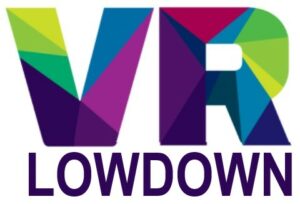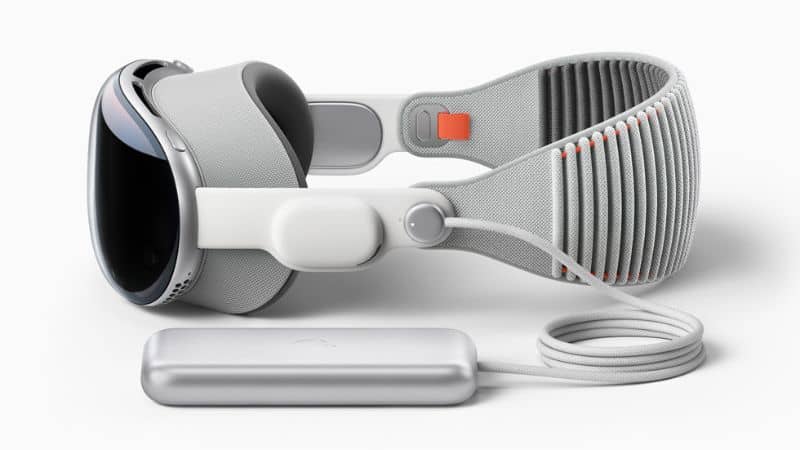
In a fascinating announcement at WWDC 2023, Apple again aims to make its mark in a growing technology market, this time by introducing the Apple Vision Pro. The tech giant, renowned for its game-changing innovations, has now unveiled a device that will have huge implications for the augmented reality industry. Let’s delve into this new product’s groundbreaking features that promise to transform and electrify the world of VR and AR.
A New Era Of Spatial Computing
As Apple CEO, Tim Cook announced “one more thing” at WWC 2023, almost everyone watching knew they were in for a treat, as Apple was about to announce their first major new product category since the Apple Watch.
Apple heralds the Vision Pro headset as a spatial computer that blurs the line between the digital and physical world. It is a sleek and futuristic headset packed with an impressive amount of processing power and sensors that represent a significant leap forward for the VR/AR industry.
Pitched very much as an augmented reality headset, it allows you to be immersed in a digital environment, whilst retaining as much or as little awareness of the real world as you wish, making it a much less isolating experience than a lot of VR headsets.
It has a pioneering operating system, VisionOS, that opens up a three-dimensional interface, allowing users to scale and place apps beyond the confines of a conventional display, using their eyes, hands, and voice for control. It’s pitched as a serious productivity tool that impressively integrates with your other Apple devices.
At an initial price point of $3,499, the Apple Vision Pro poses a hefty investment for a glimpse into the future of computing. Apple anticipates that the device will hit the market early next year, with sales initially confined to U.S. Apple retail outlets. This limited availability may be due to the manufacturing bottleneck that this headset will present, or could be a strategic move, offering the global tech giant an opportunity to gauge and respond to user reactions before rolling it out on a larger scale.
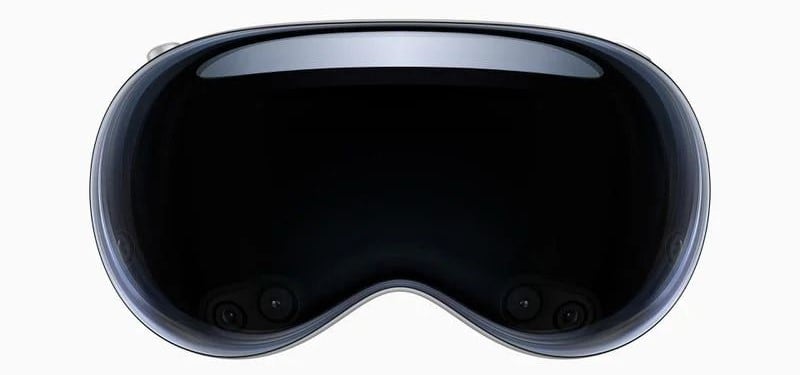
Apple Vision Pro Features
In the much-anticipated reveal of Apple’s Vision Pro headset, the company announced an impressive array of features that place it at the cutting edge of spatial computing.
Control of the Vision Pro headset relies on the user’s eyes, hands, and voice. Users can browse apps by merely looking at them, use finger taps for selection, wrist flicks for scrolling, or utilize voice commands. The device also offers compatibility with Apple’s Magic Keyboard and Magic Trackpad.
An innovative feature, called “EyeSight,” presents passthrough video of the wearer’s eyes, allowing others to maintain eye contact. A lenticular OLED display ensures the correct viewing perspective, enhancing the immersive experience.
With Vision Pro, personal spaces transform into custom-sized movie theaters, with the capacity for viewing immersive videos. The “Environments” feature allows the expansion of a user’s space beyond physical constraints, overlaying dynamic landscapes for enhanced focus. Additionally, the Vision Pro offers Mac connectivity, enabling users to extend their Mac’s display into a virtual space alongside apps running on the Vision Pro.
For FaceTime calls, all participants are reflected in life-sized tiles, with Vision Pro wearers appearing as “Personas” – digital avatars of themselves.
Security features include the innovative “Optic ID,” which uses iris recognition for user authentication and device unlocking. Additionally, the Vision Pro boasts Apple’s inaugural 3D camera, capable of providing depth perception in videos along with Spatial Audio, adding a new dimension to the audio-visual experience.
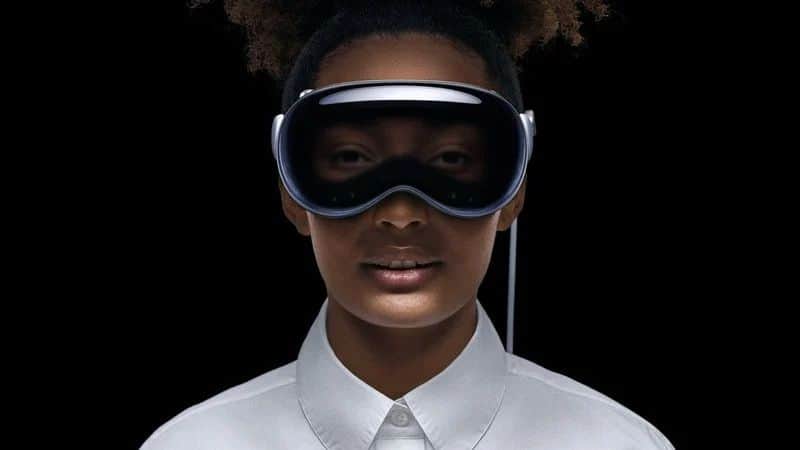
Apple Vision Pro Design And Technology
The front of the Vision Pro is a three-dimensionally formed and laminated glass lens, polished to an optical surface. This singular piece integrates EyeSight technology and a multitude of cameras and sensors, offering an expansive view of the world.
An aluminum frame houses the main components of the device, including a button for spatial photos and videos, and a Digital Crown to control the immersion levels of environments. Despite its compact form, the Vision Pro encases a high-performance computer, sensors, cameras, and displays, all cooled by an efficient thermal design.
Adopting a modular design approach, Apple has developed a product that offers a tailored fit for every user, accounting for variations in face angle, head shape, and cheek width. The customizable LightSeal conforms to the user’s face, providing a precise fit, and flexible straps keep the audio pods close to the user’s ears, offering a rich spatial audio experience.
The Vision Pro supports two hours of use with the external, high-performance battery, and can also be used all day when plugged in. The battery is housed separately, reducing the weight on the head, and can easily be carried in a pocket, connected via a woven cable.
Apple partnered with Zeiss to create custom optical inserts for the Vision Pro, accommodating a range of vision corrections without compromising display performance or eye-tracking accuracy.
The device employs a custom micro‑OLED display system that features 23 million pixels across two panels, delivering a 4K resolution for each eye, and packing 64 pixels into the space of a single iPhone pixel, each measuring 7.5 microns wide. It has a specially designed three‑element lens that aims to provide exceptional clarity throughout your field of view. Alongside this, it introduces a new spatial audio system, making sounds appear as if they are emanating from the surrounding environment, instead of the device itself.
Powering this spatial computer are two Apple silicon chips: the M2 chip, which delivers impressive computing performance while maintaining a comfortable temperature, and the new R1 chip, responsible for real-time sensor processing.
The Vision Pro introduces EyeSight, a curved OLED panel that projects the perspective of your eyes to each observer, making the device look transparent. It also employs advanced machine learning techniques to create a digital Persona that can communicate with over a billion FaceTime-capable devices.
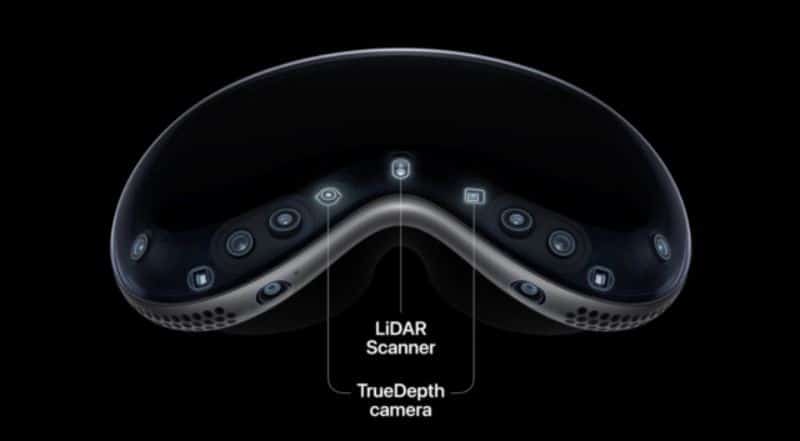
VisionOS
The Vision Pro is powered by a pioneering operating system named visionOS. Developed by Apple, visionOS is the industry’s first OS devised explicitly for spatial computing, marking the commencement of a new platform entirely.
Innovatively, the Vision Pro boasts an interface operated via the most organic and intuitive inputs at a user’s disposal: their eyes, hands, and voice. With support for eye and hand tracking, users can navigate apps by merely looking at them, selecting with a tap of their fingers, scrolling by flicking their wrist, or dictating via voice commands.
VisionOS will feature an exclusive App Store for Vision Pro, hosting bespoke apps developed for this new platform. Additionally, the system will be compatible with hundreds of thousands of iPhone and iPad apps, seamlessly integrating with the new Vision Pro’s input system.
Taking spatial computing to new heights, users can arrange apps in a spatial representation of their surroundings, facilitated by a 3D interface that liberates apps from the confines of a traditional display. Apps can exist side by side, unrestricted by scale.
Furthermore, Vision Pro supports Magic Keyboard and Magic Trackpad. It even allows users to display and control their Mac within the headset via a virtual 4K display.
Applying this immersive experience to social interactions, apps such as FaceTime empower users to place call participants around the environment in life-sized tiles, complete with spatial audio for correct voice positioning. Users joining a FaceTime call via Vision Pro will be represented by a ‘Persona’ – a dynamic, digital avatar of the user. This ‘Persona’ is generated using Apple’s most advanced machine learning techniques, offering real-time reflection of facial expressions and hand movements.
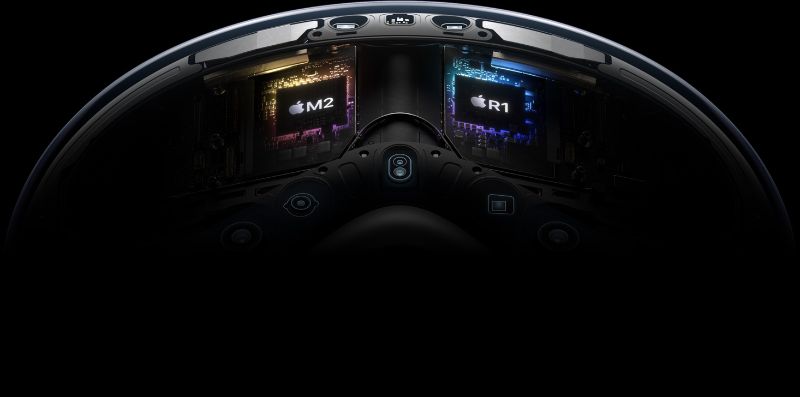
An Immersive User Experience
Alan Dye, Apple’s Vice President of Human Interface Design, explained that the Apple Vision Pro was designed with a fully three-dimensional interface – one controlled solely by your eyes, hands, and voice. Upon putting on the Vision Pro, you immediately see your space and everything within it. The Home View, right before you, hosts all your apps in a format that feels familiar yet revolutionary.
The design of the interface ensures every element appears truly present in your room, with each aspect having its own physicality. Items have dimension, dynamically respond to light, and even cast shadows to help you comprehend scale and distance.
The Vision Pro’s interface allows apps to freely fill the space around you. It enables you to resize apps to any scale and place them anywhere in your space, emulating the movement of real objects. Launching new apps doesn’t encroach on the space occupied by existing ones. Instead, they simply find a new space within the expansive canvas surrounding you. The ability to see your favorite apps and experiences in the room with you is nothing short of extraordinary.
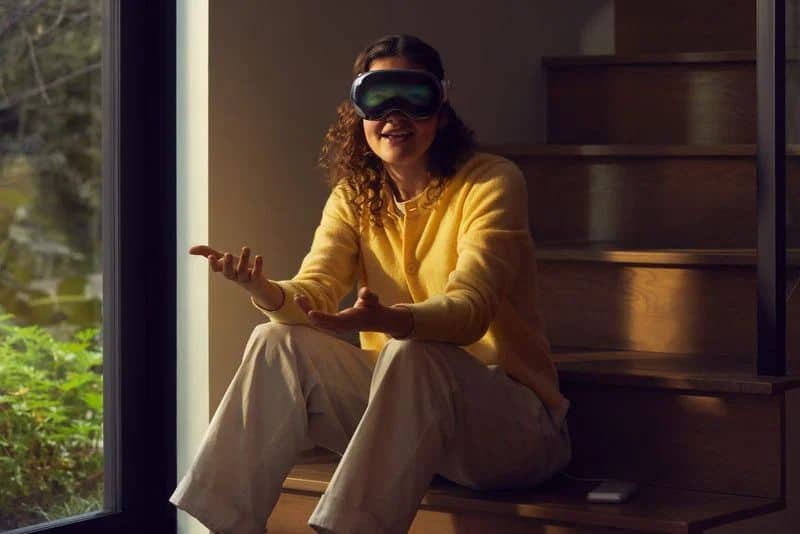
Intuitive Input Model for Spatial Computing
Vision Pro pioneers a highly intuitive input model for spatial computing. A significant departure from other augmented reality devices, it relies solely on your eyes, hands, and voice. No controllers or additional hardware are needed. This remarkable technology makes it seem as if your mind is guiding the experience.
Vision Pro is equipped with an eye-tracking system, allowing it to understand exactly where you’re looking, enabling fine control and interaction with the digital world. This system is so precise that it can detect and understand even minute eye movements, enabling new modes of interaction such as ‘Gaze Control’ where your eyes act as a pointer to navigate through digital content.
Hand gestures too have been elegantly incorporated into the interface. Apple Vision Pro can detect and understand a wide range of hand and finger movements, which gives you the freedom to interact naturally with the virtual objects in your space.
Voice is the third pillar of Vision Pro’s input model. Leveraging Apple’s advanced Siri technology, you can control Vision Pro with just your voice. Whether it’s launching applications, controlling playback, or dictating messages, Siri becomes your efficient, intelligent assistant in the AR realm.
My Thoughts On Apple Vision Pro
As someone deeply entrenched in the VR and AR industry, it isn’t often I’m caught off guard. Yet, Apple’s Vision Pro managed to surprise me with its rich feature set. The engineering and technological prowess of this headset vastly outstrip its competitors, coupled with a robust design and a well-considered emphasis on AR and productivity.
Initially, my expectations were for Apple to showcase a VR device that outperformed rivals in terms of features and design, with a particular slant towards augmented reality. Apple has demonstrated an acute understanding of the primary disadvantage of VR – its propensity to isolate users from their immediate surroundings. The design of the Vision Pro addresses this concern thoughtfully, providing users with the option to maintain a sense of presence in their physical space.
Critics will inevitably point out the seemingly cumbersome nature of the device, the need for an external battery to fuel a mere two hours of operation, the unconventional EyeSight feature, the eye-watering price, and the somewhat eerie digital avatars. However, for those who have followed the development of the VR industry, this iteration represents yet another stride forward in the relentless progression of VR/AR technology.
The Vision Pro is poised to be a remarkable tool for productivity and creative pursuits, particularly within industry circles. Its array of entertainment features caters to those with deep pockets or the insatiable desire to possess the latest tech marvel.
With a starting price point of $3500, the Vision Pro is indeed a luxury. This is not a device for the average consumer, and as such, sales are likely to remain modest. For most, the Vision Pro represents a marker of Apple’s bold entrance into the VR/AR sector. However, the prospect of acquiring such a headset won’t truly resonate with most users until subsequent, more accessible versions are released over the coming years.
Apple’s debut in the VR/AR domain is a tentative first step, and it will require time for the technology to mature and the user base to expand. Yet, Apple’s introduction of an extraordinarily impressive product signifies a significant catalyst for innovation and competition in the industry. As with the smartphone, tablet, and smartwatch sectors, this move is set to have a positive ripple effect, benefitting all users in the long run.
